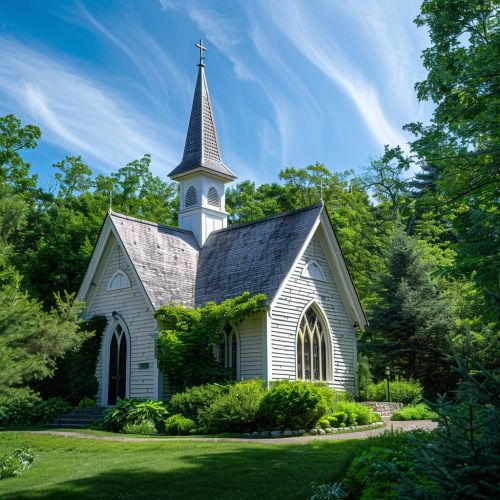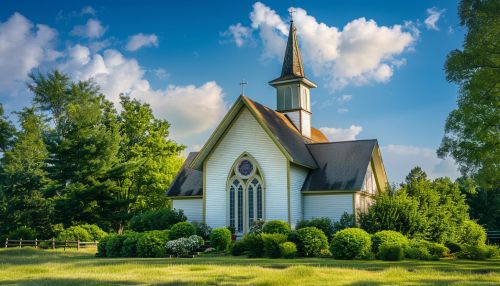Freedom of religion in the United States: Difference between revisions
(Created page with "== Historical Background == The concept of freedom of religion in the United States has its roots in the early colonial period. The First Amendment to the United States Constitution, ratified in 1791, explicitly prohibits the federal government from making any law "respecting an establishment of religion, or prohibiting the free exercise thereof." This clause is often referred to as the "Establishment Clause" and the "Free Exercise Clause." <div class='only_on_...") |
No edit summary |
||
| Line 3: | Line 3: | ||
The concept of [[freedom of religion]] in the United States has its roots in the early colonial period. The [[First Amendment]] to the United States Constitution, ratified in 1791, explicitly prohibits the federal government from making any law "respecting an establishment of religion, or prohibiting the free exercise thereof." This clause is often referred to as the "Establishment Clause" and the "Free Exercise Clause." | The concept of [[freedom of religion]] in the United States has its roots in the early colonial period. The [[First Amendment]] to the United States Constitution, ratified in 1791, explicitly prohibits the federal government from making any law "respecting an establishment of religion, or prohibiting the free exercise thereof." This clause is often referred to as the "Establishment Clause" and the "Free Exercise Clause." | ||
[[Image:Detail-91783.jpg|thumb|center|A traditional American church with a steeple and surrounding greenery.|class=only_on_mobile]] | |||
[[Image:Detail-91784.jpg|thumb|center|A traditional American church with a steeple and surrounding greenery.|class=only_on_desktop]] | |||
=== Colonial Period === | === Colonial Period === | ||
Latest revision as of 16:21, 19 June 2024
Historical Background
The concept of freedom of religion in the United States has its roots in the early colonial period. The First Amendment to the United States Constitution, ratified in 1791, explicitly prohibits the federal government from making any law "respecting an establishment of religion, or prohibiting the free exercise thereof." This clause is often referred to as the "Establishment Clause" and the "Free Exercise Clause."


Colonial Period
During the colonial period, various colonies had different approaches to religious freedom. For example, Rhode Island was founded by Roger Williams, who advocated for the separation of church and state. In contrast, colonies like Massachusetts had established churches and were less tolerant of religious dissent.
Constitutional Framework
The Constitutional Convention of 1787 did not initially include specific protections for religious freedom. However, the lack of explicit protections became a point of contention during the ratification debates, leading to the inclusion of the First Amendment in the Bill of Rights.
Legal Interpretations
Early Supreme Court Cases
The United States Supreme Court has played a crucial role in interpreting the First Amendment's religious clauses. Early cases like Reynolds v. United States (1878) established that while religious beliefs are protected, religious practices that violate general laws are not.
Establishment Clause
The Establishment Clause has been the subject of numerous landmark cases. In Everson v. Board of Education (1947), the Supreme Court ruled that the Establishment Clause applies to state governments through the Fourteenth Amendment. This case set the precedent for the "wall of separation" between church and state.
Free Exercise Clause
The Free Exercise Clause has also been extensively litigated. In Sherbert v. Verner (1963), the Supreme Court introduced the "Sherbert Test," which requires the government to demonstrate a compelling interest before burdening an individual's religious practices. However, this test was later modified by the Employment Division v. Smith (1990) decision, which held that neutral laws of general applicability do not violate the Free Exercise Clause.
Modern Developments
Religious Freedom Restoration Act (RFRA)
In response to the Employment Division v. Smith decision, Congress passed the Religious Freedom Restoration Act (RFRA) in 1993. RFRA reinstated the "compelling interest" test for cases involving religious freedom. However, the Supreme Court ruled in City of Boerne v. Flores (1997) that RFRA could not be applied to state laws, leading to the enactment of state-level RFRAs.
Recent Supreme Court Cases
Recent cases have continued to shape the landscape of religious freedom in the United States. In Burwell v. Hobby Lobby Stores, Inc. (2014), the Supreme Court held that closely-held corporations could be exempt from regulations that violate their religious beliefs. Another significant case, Masterpiece Cakeshop v. Colorado Civil Rights Commission (2018), addressed the conflict between religious freedom and anti-discrimination laws.
Social and Cultural Impact
Religious Diversity
The United States is home to a diverse array of religious beliefs and practices. This diversity has been both a source of strength and a point of contention. The presence of multiple religious communities has necessitated a legal framework that accommodates various beliefs while maintaining social cohesion.
Secularism and Pluralism
The principle of secularism, or the separation of church and state, has been a cornerstone of American democracy. However, the rise of religious pluralism has challenged traditional notions of secularism. The increasing visibility of non-Christian religions has led to debates over the role of religion in public life.
Challenges and Controversies
Religious Discrimination
Despite legal protections, religious discrimination remains a significant issue in the United States. Various religious groups, including Muslims, Jews, and Sikhs, have faced discrimination and hate crimes. The federal government has enacted laws like the Religious Land Use and Institutionalized Persons Act (RLUIPA) to address these issues.
Balancing Rights
Balancing religious freedom with other rights, such as LGBTQ+ rights, has been a contentious issue. Cases like Obergefell v. Hodges (2015), which legalized same-sex marriage, have sparked debates over the extent to which religious beliefs can justify exemptions from anti-discrimination laws.
Conclusion
Freedom of religion in the United States is a complex and evolving issue. The legal framework established by the First Amendment has provided robust protections for religious freedom, but ongoing legal and social challenges continue to shape its interpretation and application. As the United States becomes increasingly diverse, the balance between religious freedom and other societal values will remain a critical area of legal and cultural discourse.
